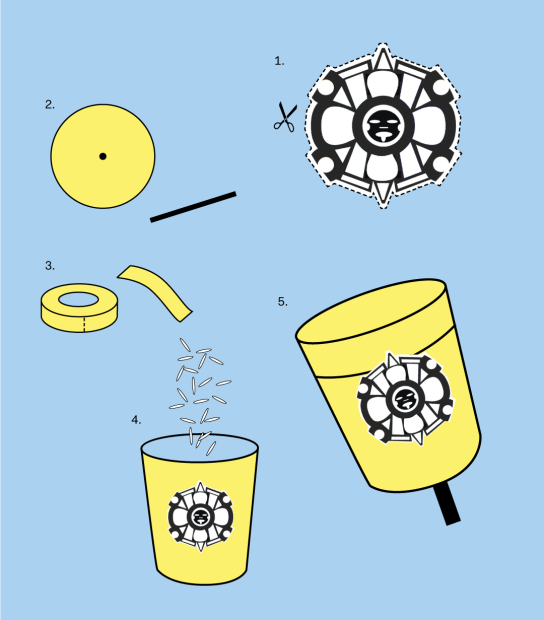The Aztecs used a variety of wind and percussion instruments to make music, including rattles and different kinds of drums. For the Aztecs, dance and songs were ways of praying and meditating to be in harmony with nature, earth, and the universe. In their dances they represented the elements (Wind, Fire, Water, and Soil) and performed to the four cardinal points (North, South, West, and East) to request from Mother Earth the permission to live and work.
The symbol “Nahui Ollin” (pro — nounced as naw-wee-oh-leen) represents the day of the Aztec calendar associated with Xolotl. Xolotl is the god of shifting shapes, twins, and Venus, the Evening Star. Nahui means four, and Ollin means movement.
There are beautiful songs and poetry in Nahuatl, the language of the Aztec people and their descen — dants. Create your own Ayacachtli, or Aztec rattle, and play and sing along to “Huey Tonantiz,” which means Great Mother Earth.
_____________________________________________________________________
Los aztecas usaban una variedad de instrumentos de viento y de percusión para crear música, como sonajeros y diferentes tipos de tambores. Para los aztecas, la danza y las canciones eran maneras de rezar y meditar para estar en armonía con la naturaleza, la tierra y el univer — so. En sus danzas, representaban los elementos (aire, fuego, agua y tierra) y bailaban en dirección a los cuatro puntos cardinales (Norte, Sur, Este y Oeste) para pedirle per — miso a la Madre Tierra para vivir y trabajar.
El símbolo de “Nahui Ollin” (se pronuncia na-hui-o-lin) representa el día de Xolotl en el calendario azteca. Xolotl es el dios de las formas cambiantes, los mellizos y Venus, la estrella de la tarde. Nahui significa cuatro, y Ollin significa movimiento.
En el idioma de los aztecas y sus descendientes, el nahuatl, existen bellas canciones y poemas. Crea tu propio ayacachtli, o sonajero azteca, para tocar y cantar “Huey Tonantiz,” que significa la Gran Madre Tierra.
Materials / Materiales:
- A paper cup or container with a lid / Un vaso de papel o un envase con taparojos
- A handful of uncooked rice, dried beans, or other material for filling your Ayacachtli / Un puñado de arroz sin cocinar, frijoles secos u otro material similar para llenar el ayachachtli
- Drawing and coloring tools, like crayons or colored pencils / Elementos para dibujar y colorear, como crayones o lápices de colores
- Glue / Pegamento
- Scissors / Tijeras
- One skewer or stick / Una brocheta o un palillo
- Colored masking tape / Cinta de enmascarar de color
Instructions / Instrucciones:
|
1. Decorate your cup. Color and cut out the image of the “Nahui Ollin” symbol. Glue it on to your cup. Add your own drawings and symbols. Be as creative as you like! 2. Very carefully (and with adult supervision), create a small hole in the bottom of the cup and insert the stick into the cup to attach it. 3. Use the masking tape to wrap the stick and secure it to the cup. 4. Fill your cup with rice. 5. Close the cup with the lid and seal it with masking tape. Note: The sound will be louder with rice. It will sound different if you use beans. You can also try plastic beads or other similar mate — rials. Explore the sounds and beats of nature and try to imitate them with your Ayacachtli.
|
1. Decora el vaso. Colorea y recorta la ima — gen del símbolo de “Nahui Ollin”. Pégalo al vaso. Agrega tus propios dibujos y símbolos. ¡Sé todo lo creativo que quieras! 2. Con mucho cuidado (y con la supervisión de una persona adulta), crea un pequeño orificio en el vaso e inserta el palillo en él para unirlo. 3. Forra el palillo con la cinta adhesiva y sujétalo al vaso. 4. Llena el vaso con arroz. 5. Cierra el vaso con la tapa y séllalo con cinta adhesiva. Nota: El sonido será más fuerte si usas arroz. Sonará diferente si empleas frijoles. Tam — bién puedes probar con cuentas de plástico y otros materiales parecidos. Investiga los sonidos y los ritmos de la naturaleza e intenta imitarlos con tu ayacachtli. |
|
IN ENGLISH “GREAT MOTHER EARTH” Great Mother Earth Translated by Veronica Robles
|
“HUEY TONANTZIN” ¡Huey Tonantzin, Tonantzin, ¡Huey Tonantzin, Tonantzin, Ipalnemohuani Noyolo Paqui Ipalnemohuani Noyolo Paqui EN ESPAÑOL “GRANDIOSA MADRE TIERRA” Grandiosa Madre Tierra, Traducido por Veronica Robles |
This activity was developed by Veronica Robles, a Mariachi singer, musician, and folkloric dancer. Robles has become a cultural icon for Latinos in Boston. She has effectively utilized the power of arts and culture to bring the community together by raising awareness on the importance of diversity. She offers in-person and virtual educational programs for K-12 students in schools and cultural organizations.
Veronica Robles es una cantante, música y bailarina folklórica mariachi que se ha convertido en un referente cultural para los latinos de Boston. Ha recurrido de manera eficaz al poder del arte y la cultura para reunir a la comunidad al crear conciencia sobre la importancia de la diversidad. Ofrece programas presenciales y virtuales para estudiantes de primaria y secundaria en escuelas y organizaciones culturales.
